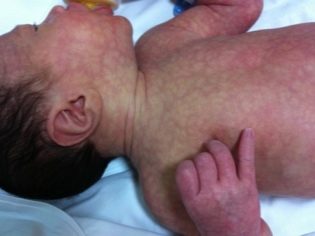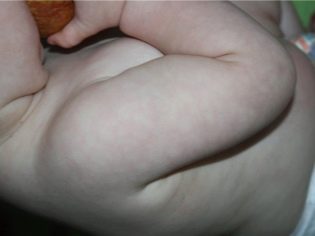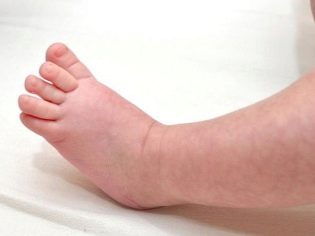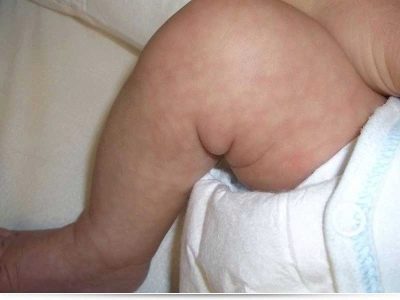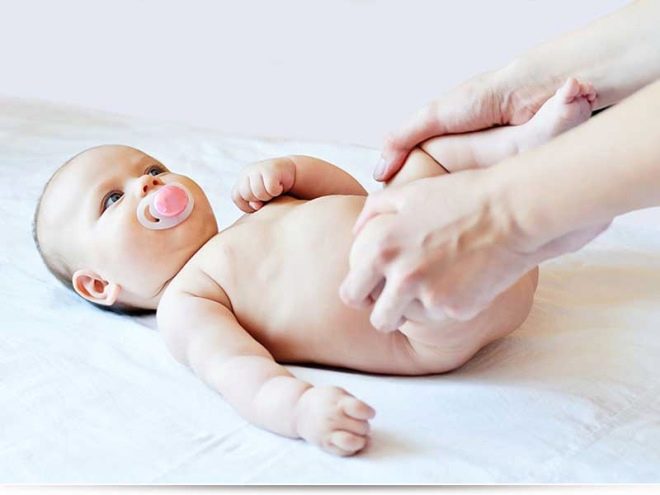Marble skin in infants and newborns: causes, symptoms, and treatment
In all commercials and on photos in magazines, newborns and babies look like pink peaches - their skin is delicate, velvety, even, monochromatic in color. In life, everything often happens quite differently. The skin color of infants affects their diversity and variability. The greatest number of anxieties and experiences in young mothers and fathers is caused by marble skin in a child, when the vessels peek and form a pattern that resembles the appearance of marble. That is it and whether it is dangerous, we will tell in this article.
What it is
Marble skin in infants is a very extensible and voluminous concept. Unusual shade and peculiar pattern on the skin can be both a sign of the disease and a variant of the physiological norm. Usually marbling is observed on the entire area of the skin, although in certain cases, the marble "mesh" can be formed only on the cheeks or only on the handles of a child.
The overall color of the skin can be both pale and reddish, and the vascular grid itself, forming the marble pattern, is either reddish or all shades of blue.
Marble skin itself is not considered a pathology, such a symptom is always evaluated in combination with other possible diseases and conditions.
Most often marbling is observed in children who inherit from their parents light, pale skin. Dark-skinned babies exhibit this color of the skin much less frequently.
Physiological origin
In 90% of cases, this skin in a child speaks of quite understandable and harmless reasons. The skin of newborns is much thinner and more vulnerable than the skin of adults. It is more susceptible to any external influences, and especially to temperature extremes. If an adult does not feel a drop of 1-2 degrees, as a rule, at all, then for a newborn such a drop is very noticeable.
Thermoregulation in babies who have just been born is imperfect. And the circulatory system is still being rearranged for independent work, devoid of placental replenishment. The vessels and capillaries themselves are too close to the skin. Under the influence of various external factors, including temperature changes, some vessels can expand, others - to narrow. Extended through the skin look more red, narrowed - more blue. So marbling is formed.
Sometimes such an unusual color of skin can sometimes have, if a child is bathed in cool water, dressed in a cool room, and can be almost always marble, only slightly changing the intensity and contour of the marble pattern. There are no other disturbing symptoms in physiological marbling, the child is healthy, eats well, sleeps, develops and gains weight within the limits of average norms. Parents are satisfied with absolutely everything, except for the skin tone of the baby.
This condition does not require any treatment or other measures. Typically, by 3-4 months in a child, thermoregulation is established, blood circulation in small vessels improves, and the reticulum disappears by itself. This process may be delayed, but after half a year the physiologically determined marble mesh is already a rarity.
Most often, this innocuous natural marbling is characteristic of children who were born after difficult and long births, to babies who had hypoxia while they were in the womb of the mother, premature tops, and children who had had an intrauterine infection.
Pathological origin
Marble pattern on the skin can talk about possible health problems. In this case, the skin manifestations are combined with other symptoms and signs characteristic of this or that disease.
Such an unusual skin quite often accompanies a cyst or dropsy of the brain, congenital heart defects, encephalopathy, obtained in the perinatal period.
In this case, marbling has a painful tint (similar in appearance to gray marble), pale skin, vessels are narrowed, vascular mesh is bluish. The skin is almost always cool and prone to sweating, the nasolabial triangle often has a bluish color.
Parents will not be sure at home about the reasons for such a marble shade, since almost all diseases that accompany such skin color are easily diagnosed in the early neonatal period, and parents will find out about such ailments if not at the maternity hospital, then at the time of the first medical examination which takes place in 1 month.
Quite often, the appearance of marble skin parents of babies notice during the illness of the child, on the background of high temperature. In this case, we can talk about the so-called white fever - a condition in which a spasm of peripheral vessels occurs in the background of heat in a child. At high temperatures, the child’s hands remain cold, and a marble mesh may appear on the skin.
Rare causes
There is a marbling syndrome in the medical encyclopedias. This is a very rare congenital disease, which is associated with vascular pathology. Since 1970, only a little more than 200 cases of true marbling have been recorded worldwide. In addition to the unusual appearance of the skin, anomalies of the development of blood vessels cause other changes in the children's body. All of them are well diagnosed immediately after birth. True marble skin is accompanied by brain microcephaly, gigantic, including flaming nevi.
With a rare congenital disease in a child, in addition to marbling, there is an asymmetry of the face and body, limbs, and gross pathologies in the structures of the brain and central nervous system. The skin at this disease are permanent purple hue. Vascular mesh is very well distinguishable. In order to confirm such a diagnosis, the geneticist will have to make an intercom with foreign colleagues, since in Russia, the disease is very little studied, and all the bright, described and relatively studied cases were recorded mainly in the West, although even there it is difficult to make predictions on innate marbling - too little practice.
Diagnostics
If a newborn at some point parents found signs of marbling of the skin, you should not panic, but you should not ignore such a sign either. If the marble pattern appears again and again, you need to try to understand what factors favor it and be sure to tell the pediatrician about it at the next appointment.
If the condition of the child inspires more real fears and there are other symptoms of a possible pathology, then it is impossible to delay the treatment to the doctor.
Depending on the condition of the baby, the doctor prescribes a consultation with a cardiologist, pediatric neurologist, and rheumatologist. From diagnostic methods, an ultrasound examination of the heart and large vessels is performed, an ultrasound of the brain (until the spring is tightened, and later - MRI). The electrocardiogram and the encephalogram can tell a lot about the health of the baby. It is possible that the child will need to consult a dermatologist.
How to treat?
Physiologically conditioned marble skin does not need treatment. The condition passes by itself and in a rather short time, on average in 2-3 months. To help a child acquire strong vascular tone, parents can practice daily firming massage, dousing the child with cool water after the main swim (according to the method of children's doctor Evgeny Komarovsky, for example). The child will benefit from long walks in the fresh air, firming gymnastics and daily naked air baths.
Good practice early swimming.For the smallest (from 1 month) for swimming you can use special orthopedic circles.
Toddler prone to manifestations of marbling of the skin, categorically can not overfeed or overheat. It only enhances the strange skin manifestations. Treatment of pathological causes depends on what specific disease is detected. Many problems with vessels and congenital heart defects, which are manifested at the very early age by the marbling of the skin, require prompt or somewhat delayed surgical treatment.
In conservative therapy using vascular drugs, vitamins, physiotherapy. The main goal of treatment is to increase blood microcirculation, strengthen the walls of blood vessels. Usually, the symptoms of marble skin, if they are caused by pathology, disappear after it is possible to eliminate the main cause of the problems with the vessels. There are no medications that would help specifically from the strange color of the skin.
The treatment of congenital true marbling most of the reliable medical sources can not tell, because effective and proven methods of treatment of this extremely rare disease has not yet been developed. There are only hypotheses and theories.
Interesting Facts
A few facts about marble skin:
- Marbling of the skin may appear after a long and strong crying. It is not dangerous and passes on its own.
- In 2% of “marble” babies, such a pattern on the skin is retained as episodically manifested up to 3 years.
- In 1-2% of newborns and infants who have not found any health problems, it is not possible to establish the true cause of the marble skin. In this case, the doctors indicate that the reasons are idiopathic.
- Pediatric physiological marbling of the skin can be inherited. If a mom or dad had a skin after birth, then the child is more likely to temporarily become marble.
- In children who are overfed, physiological marbling appears quite often.
- A permanent marble "mesh" on an infant’s skin can mean that he has an increased intracranial pressure. Be sure to visit a neurologist.
- 95% of children born with Edwards and Down genetic syndromes are marbling.
- Children who after birth showed their parents a “beautiful” marble mesh on their skin, at a later age the skin is more prone to injury - they often have bruises and hematomas, even with a minor impact or an inaccurate touch of hard objects.
All about the features of the skin of newborns, see the following video.

